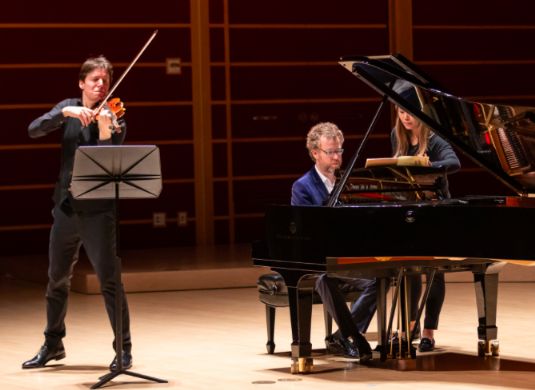Intriguing Bell-Haywood Recital Before Full House in Weill Hall (2019)

Joshua Bell and Sam Haywood. (Brennan Spark Photography)
INTRIGUING BELL-HAYWOOD RECITAL BEFORE FULL HOUSE IN WEILL HALL
by Abby Wasserman
A big portion of the capacity audience in Weill Hall February 8, 2019 came to hear violinist Joshua Bell’s
virtuosity, and were treated as well to splendid playing from Sam Haywood, Mr. Bell’s regular
pianist since 2010. The duo performed three engaging sonatas, highlighted by Mr. Bell’s sterling
technique, precise intonation and powerful thematic projection. An easy rapport between the two
was a joy to hear and observe.
Beethoven’s enigmatic fourth Sonata 4 in A minor, Op. 23, opened the program. The intense first movement, presto, launches into a gallopy dialogue from which thematic poignancy emerged with a sense of fleeting beauty. Beethoven began the sonata in 1801 when his hearing was deteriorating, and his anxiety at the time likely made its way into the work. Mr. Bell did not emphasize the sadness implicit in the first movement but let the character of the minor mode, in which most of the movement is written, predominate.
In the following andante scherzo, piu allegretto, brief fragmentary declarations moved back and
forth between piano and violin, and a fugue section resolved effectively in trills from both
instruments. In the concluding third movement, the instrumental voices sang an allegro
molto operatic duet with the music’s lyrical longing undercut by ominous rumbling. The three-note
ascending figurations in the sonata seemed to question whether to go forward or give up, but the
spritely motive from the first movement returned, and all was resolved suddenly and quietly. An
impressive and intriguing reading.
Prokofiev wrote his D Major Flute Sonata in 1942, and Soviet violinist David Oistrakh suggested the composer recast it for his instrument, giving it the opus number 94a. As performed here it was a revelation. The first of four movements (moderato) is characterized by transcendent leaps and slides and insistent rhythms, with the theme repeated in different registers and reinvented countless times; but the score also contains a certain claustrophobic feeling.
In the second, scherzo, presto, a wild dance ensues, leading toward a lyrical section where the violin part imitates bird trills and calls. Spring and rebirth are suggested in the music, with an undertone of unease, and the performer’s flying fingers brought the movement to an exciting close, inspiring some of the audience to break into applause. The artists paused until the enthusiasm abated, then proceeded to the sonata’s romantic andante, in which the opening theme is reiterated with exotic harmonies and figurations characteristic of the composer. The sonata’s finale was thrilling, with Sisyphean ascents and precipitous violin downslides. Both the last two movements are fashioned classically and emotionally “cool,” and the work ended quietly, as though with philosophical resignation.
Following intermission the artists returned to perform Grieg’s Sonata No. 2, Op. 13, a work from 1867 that isn’t played as much as the C Minor Op. 45 piece written 20 years later. The first lento doloroso movement initially reflected a dirge that settled into something quite cheerful as a mini- cadenza in the violin part stated the theme and broke into a Norwegian folk dance. Mr. Bell’s bow exhibited a light touch that underscored the music’s joy with leaps and hops of phrasing. In the second movement the violinist’s interpretation showcased quick emotional changes, and his playing in the closing allegro animato featured piquant pizzicatos, dark tonal colors and deft phrases that built momentum to a thrilling conclusion.
The audience erupted in applause. After three curtain calls, Mr. Bell addressed the audience, kindly inquiring about the condition of a patron who had fainted and been taken out during the Beethoven. He then continued that he and Mr. Haywood would finish with three short encore works, and proceeded to Clara Schumann’s Romance, Op. 22, No. 1, which he played with poignant grace and heart-stirring warmth, blending beautifully with Mr. Haywood’s soft arpeggio chords and elegant phrasing.
Joachim’s arrangement of Brahms' first Hungarian Dance came next, and here the violinist gave way to his gypsy soul, playing with dramatic verve and convincing rubato. The last encore was Wieniawski’s Scherzo-Tarantelle, Op. 16, a show-stopper work that was performed at speed, with lyrical interludes, and always with brilliant technique. Mr. Bell told the audience that he had recently returned to it after many years after playing it in his first youthful recital decades ago.
Published February 12, 2019 on classicalsonoma.org.
